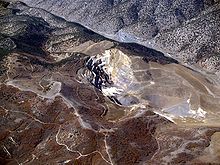- Mercur, Utah
-
Plaque in front of the Mercur Cemetery.

Mercur is a historical hard rock mining ghost town located at in Tooele County, Utah, USA. Its elevation from sea level is approximately 2,042m. The nearby Mercur Gold Mine was opened by Barrick Gold in 1985, and is presently undergoing reclamation and restoration.
Contents
History
The town first came into being in 1870 as Lewiston, when gold was discovered at the head of the Lewiston Canyon, six miles west of present-day Cedar Fort. A small gold rush began, peaking about 1873; the population reached as high as 2000.[1] In 1874 the ore started to give out, and Lewiston became a ghost town by 1880.
In 1879, a Bavarian miner named Arie Pinedo had discovered a deposit of cinnabar in the area. The ore contained gold as well as mercury, but contemporary processes were unable to extract it. Similar discoveries were made throughout the 1880s. In 1890 the advent of the cyanide process started the gold rush all over again. Gold was extracted not only from newly mined ore, but from old tailings as well. Soon there were enough people to build a new town on the old site, but the name of Lewiston was already taken by then. The citizens settled on the name Mercur, from Pinedo's claim.[1]
Amongst the miners were many members of The Church of Jesus Christ of Latter-day Saints. There was however no organization of the church in Mercur until 1896 when a branch was organized with Charles B. Felt as president. In 1899 Moses W. Reynolds, James Duckworth and Sidney S. Reynolds were sent to the town as missionaries. Their success in both bringing church members out and possibly having some convert baptisms led to the organization of a ward in Mercur on July 1, 1900 with George W. Bryan as bishop.[2]
In 1902 a fire that started in the business district of the town burned almost the entire city to the ground.[3] The town was rebuilt and mining again resumed. In its heyday there were about 5,000 residents of Mercur. This would indicate that probably less than 20% were Mormons, and active Mormons numbered even fewer.[citation needed]
Mercur supported a large Italian immigrant community; young men were attracted by the opportunity of high wages and the romance of the American "wild west". With this Italian influence, Columbus Day became an important city event including parades, games and performances by the Mercur City Band.
The ward was discontinued in 1913 because the mines had closed by then and pretty much the whole population had moved away.[2]
By 1916 there was only one building left in Mercur, and by 1930 even that was gone.
Mercur Gold Mine
The currently producing Mercur Gold Mine went into production in 1985, and is operated by Barrick Mercur Gold Mines Foundation, a wholly owned subsidiary of Barrick Gold. Annual production was about $US 20 million.[4]
Mercur is known for producing fine specimens of Lorandite, TlAsS2.[5]
References
- ^ a b Carr, Stephen L. (1986) [1972]. The Historical Guide to Utah Ghost Towns (3rd ed.). Salt Lake City, Utah: Western Epics. pp. 24–26. ISBN 0-914740-30-X.
- ^ a b Jenson, Andrew. Encyclopedic History of the Church of Jesus Christ of Latter-day Saints (Salt Lake City: Deseret News Publishing Company, 1941) p. 489
- ^ Gibson, Beth (2000). "Mercur, Utah". Utah, the Beehive State. http://hometown.aol.com/Gibson0817/mercur.htm. Retrieved 2008-02-11.
- ^ Barrick Mercur company profile
- ^ Mercur mine mineral gallery
External links
- Mercur on GhostTowns.com
- Mercur, Utah History Encyclopedia
- Mercur History, by Beth Gibson
Municipalities and communities of Tooele County, Utah Cities Towns Ophir | Rush Valley | Stockton | Vernon
CDPs Dugway | Erda | Stansbury Park
Unincorporated
communitiesBurmester | Ibapah | Lake Point
Ghost towns Coordinates: 40°19′15″N 112°12′44″W / 40.32083°N 112.21222°W
Categories:- Gold mines in the United States
- Mining communities in Utah
- Ghost towns in Tooele County, Utah
- Populated places established in 1870
Wikimedia Foundation. 2010.




